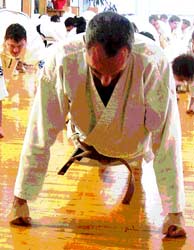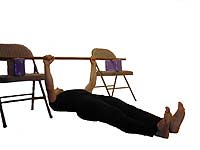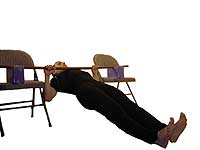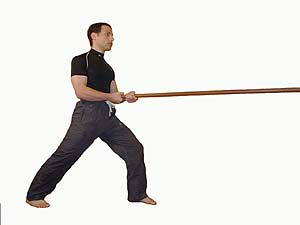Balancing The Push-up
By Paul Zaichik

If you are a martial artist you have probably been doing push-ups as
part of your training. Most people don’t realize, however, that
if they are done alone, push-ups may unbalance your natural muscular
balance.
Don’t get me wrong, push-ups are a great exercise. Everyone
does them and most practitioners believe in them. Depending on the variation,
specific muscles can be developed -- front of the shoulder, upper and
lower chest, triceps, abdominals and legs are also developed as stabilizers.
But
this article is not about usefulness or uselessness of push-ups. Instead
it is about practicing only push-ups for upper body development
and ignoring the principles of equilibrium and balanced muscle development.
If a person only practices push-ups, he or she only pushes and doesn’t
pull.
According to the equilibrium principle when you develop the front of
the body and back of the arms, you must also develop the back of the
body and front of the arms. In other words, one must train the movement
which is opposite to push-ups. STOP RIGHT THERE.
I know what most of you are thinking, and it’s wrong. Chin-ups
are not the opposite of push-ups. Without bringing kinesiological analysis
into it, just think of it this way: Standard push-ups push forward, while
standard chin-ups pull down. If you want a complementary exercise to
push-ups, you must pull back, and not down.
Many years ago this concept of equal muscular development led me to
incorporate one particular exercise into my training, which I call the “Horizontal
Pull-up”. This exercise works the muscles that are antagonists
to the movers and stabilizers of push-ups. The pictures below demonstrate
this technique. Through the years of training and teaching, I became
a strong believer and promoter of this method.
 
Speed and power of many fighting skills, including punches, blocks,
throws and locks are greatly benefited from “Horizontal Pull-ups” since
the muscles that pull back your technique are developed.
When a martial arts instructor tries to integrate this system into his
teaching, he usually faces two common dilemmas --- lack of bars or sticks,
the lack of chairs. Both of these can be solved quite easily. Instead
of bars, bo staffs can be used. For heavier students I recommend the
purchase of metal bars, which are sold in most department stores and
are relatively inexpensive.
To substitute for the chairs (to support the bars or bo staffs), I break
my students up into groups. My beginner students are broken up into groups
of three. While two students hold the bar in place, using their arms,
the third student completes the “Horizontal Pull-ups”.
 |
Shown is how one of the two students should hold a bar or a
stick. The bar’s height can be adjusted, depending on the student’s
needs. |
Each person takes turns until the required number of repetitions is
accomplished. You won’t believe the strength of the supporting
grip that this develops.
When it comes to my advanced students, I like to divide them into groups
of two. The pupil who holds the bar has two choices. First choice is
something that I call a “mid-position dead lift”, with the
bar remaining half way between the starting and ending positions, usually
above the knee level. The second choice is a squat, with elbows bent
in a biceps curl. This position is most commonly performed with palms
facing up. Whoever is executing the “Horizontal Pull-ups” can
choose to grip the bar outside or inside the hands of the supporting
person.
I would suggest that whenever you do push-ups, or have your students
do them, that “Horizontal Pull-ups” be added.
About The Author:
Paul Zaichik is an athletic trainer and the author of "ElasticSteel
Method of Athletic Conditioning Strength & Flexibility" as well
as his latest "The Gravity Advantage" Books. His education
is in Exercise Physiology and Nutrition. After training in many sports,
he began his martial arts practice in 1990. He currently teaches and
coaches such sports and activities as Yoga, gymnastics, dance, pilates,
soccer, track and field, weight training, activity specific conditioning,
and martial arts, among many others. He also helps athletes in post-
rehab, using such modalities as hypnosis, nutrition, and massage. ElasticSteel
method of athletic conditioning, incorporates many modalities for specific
athletic needs. His website is: www.elasticsteel.com
|